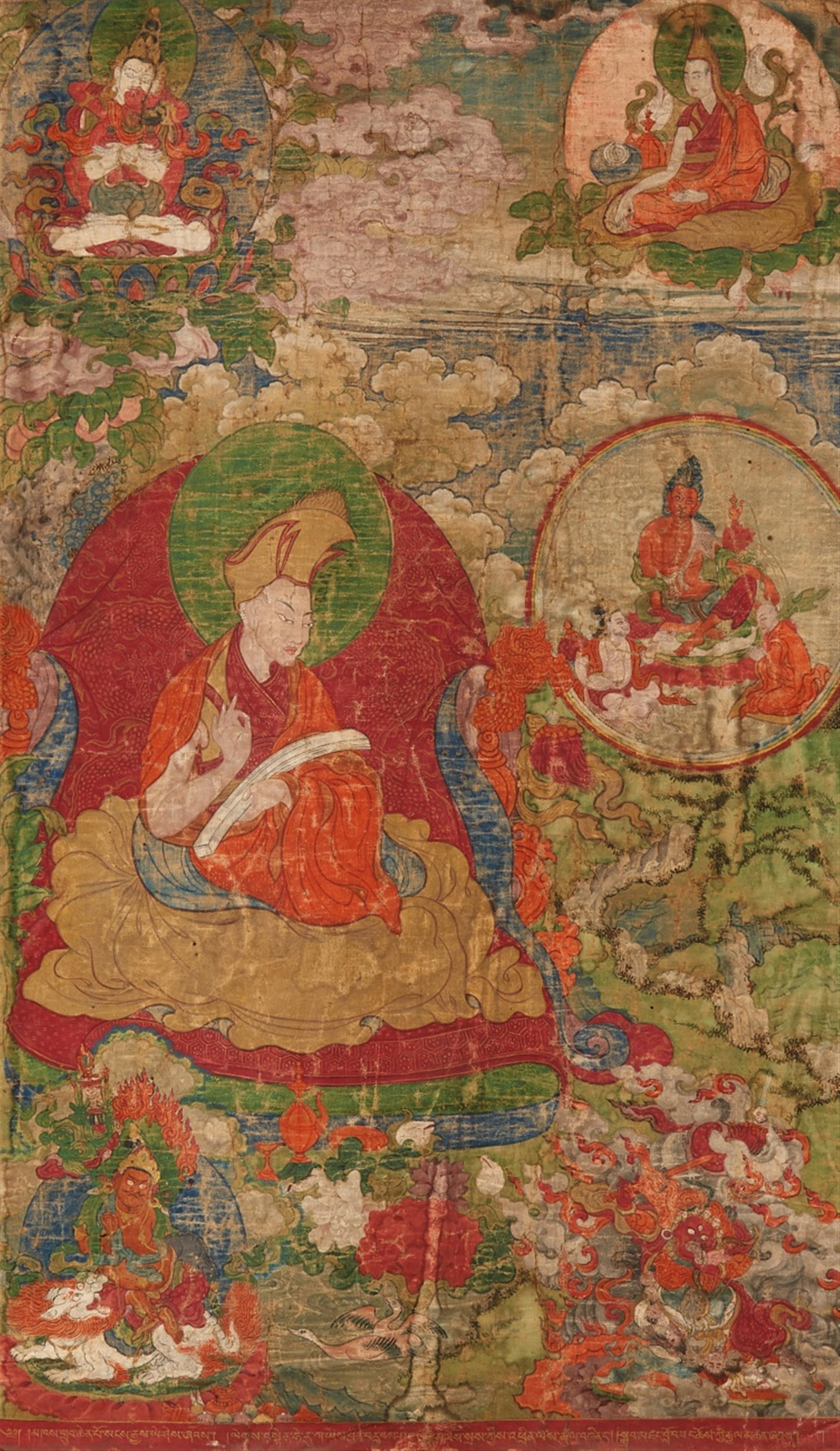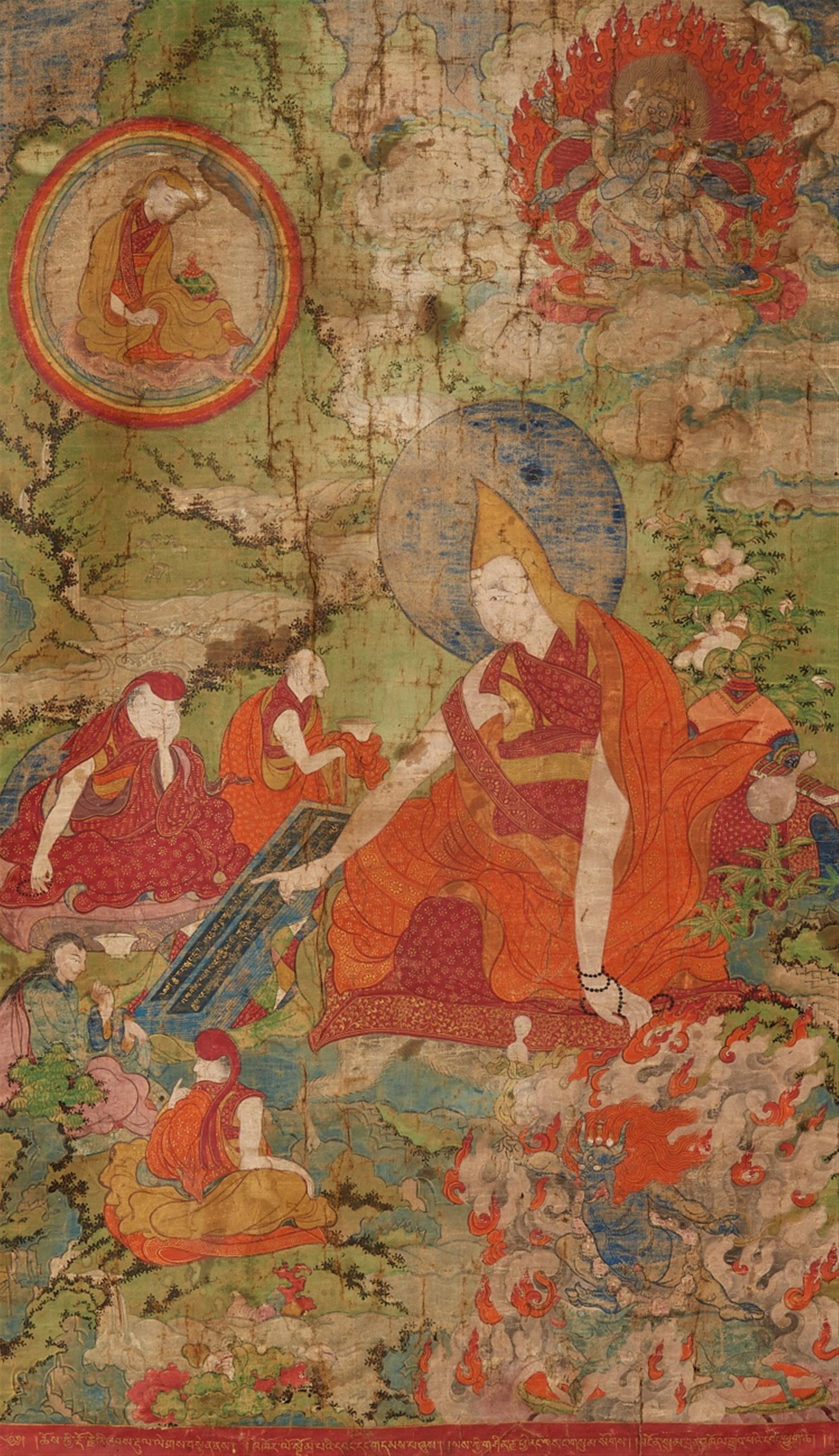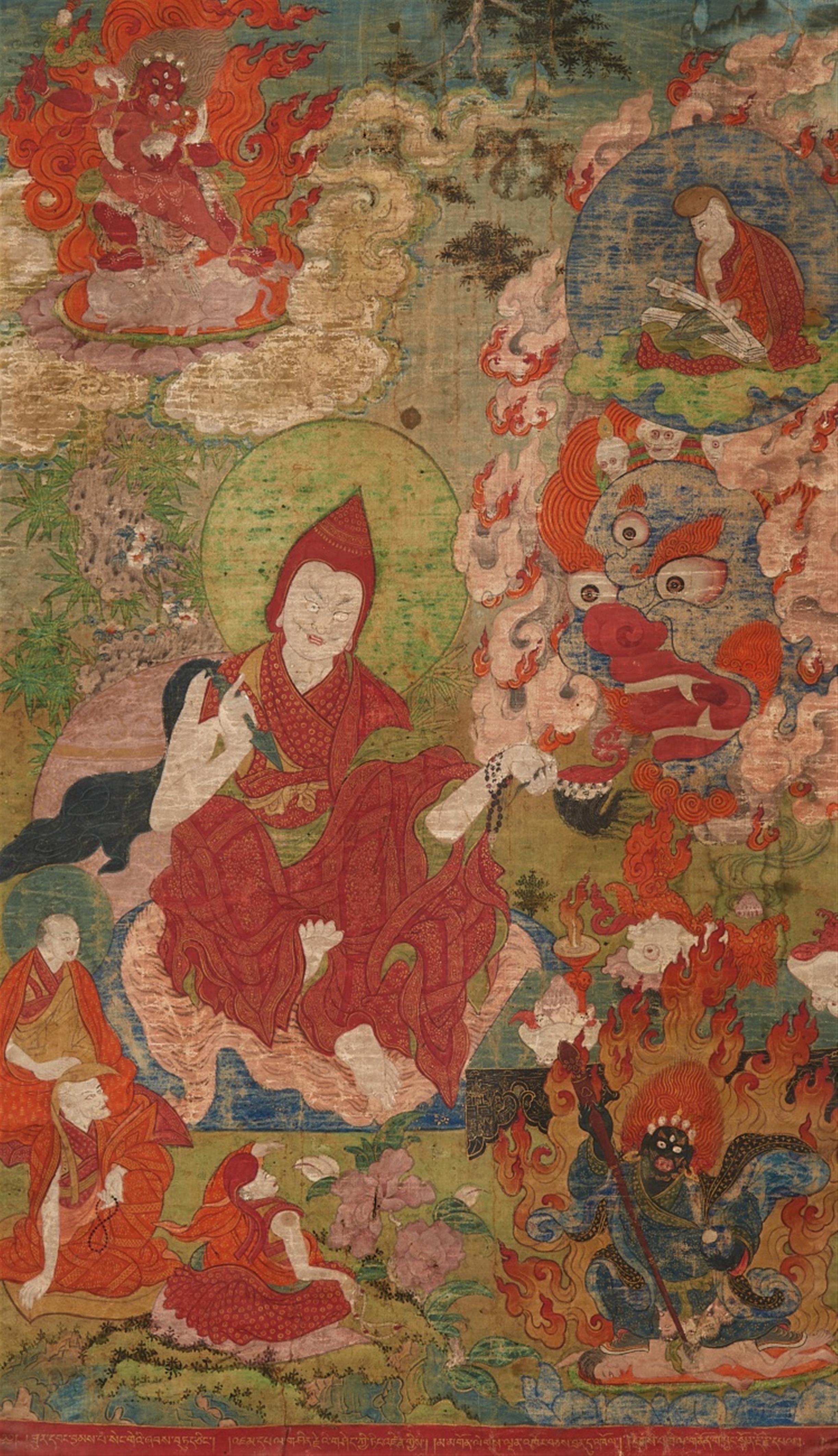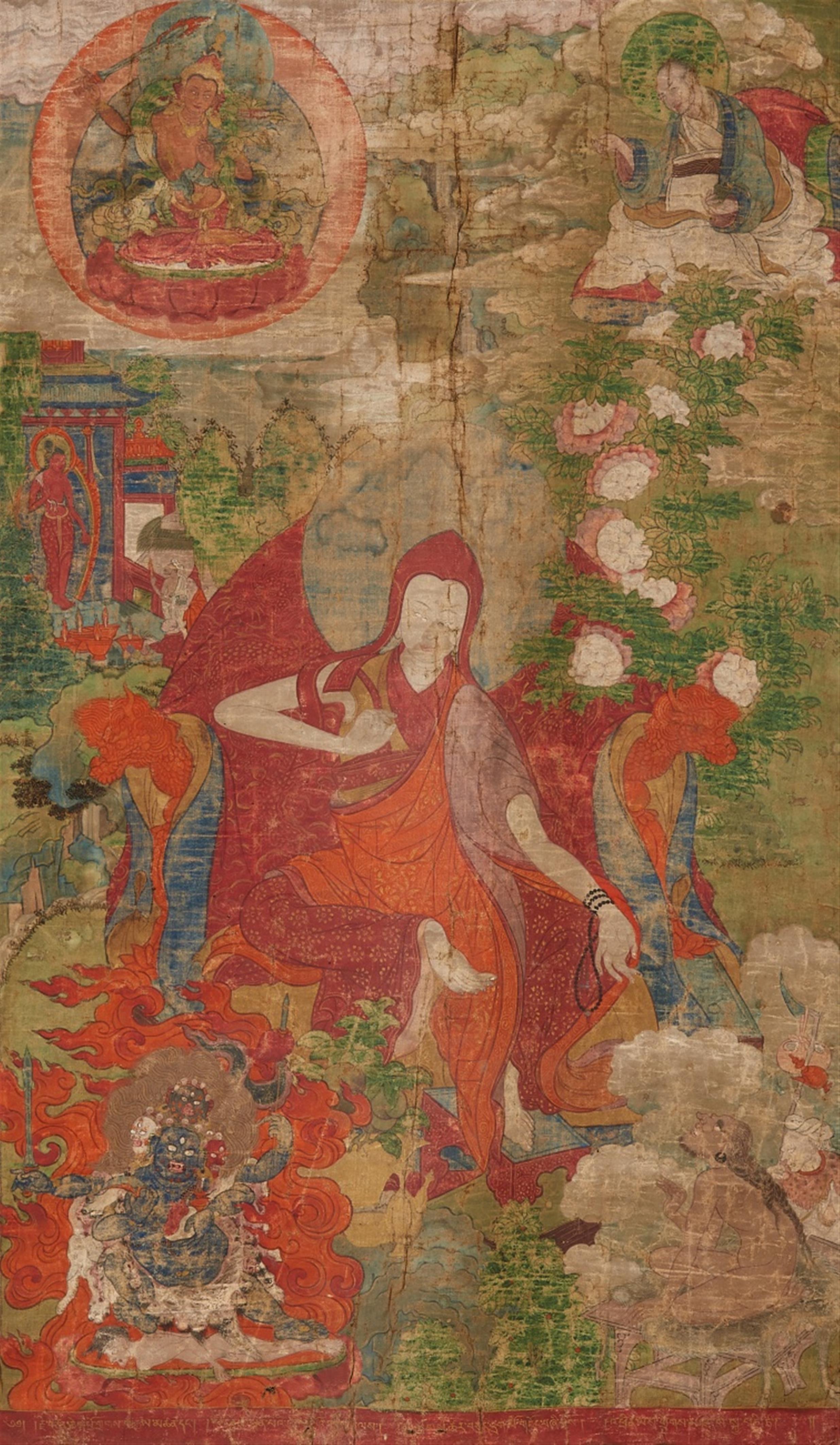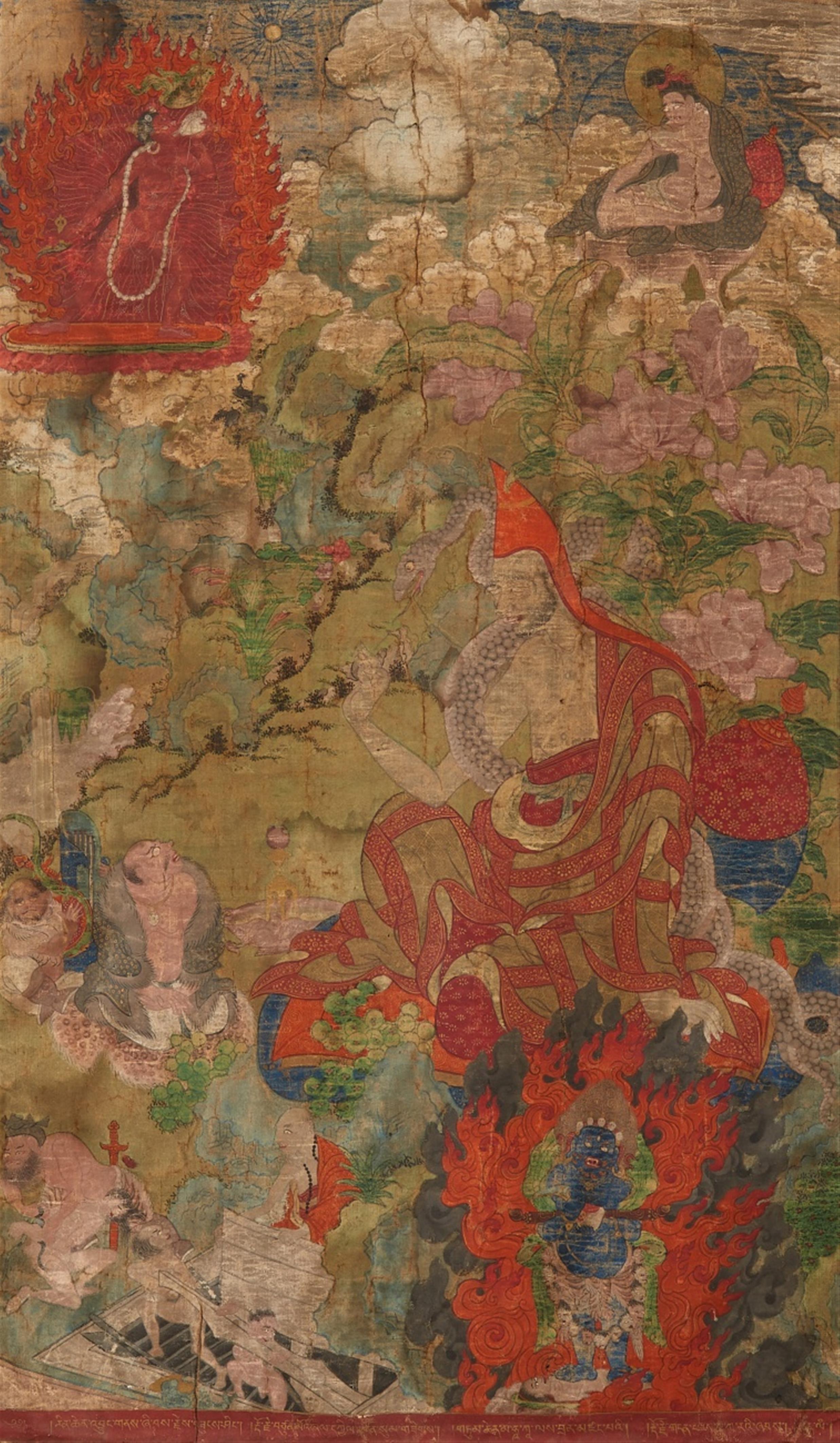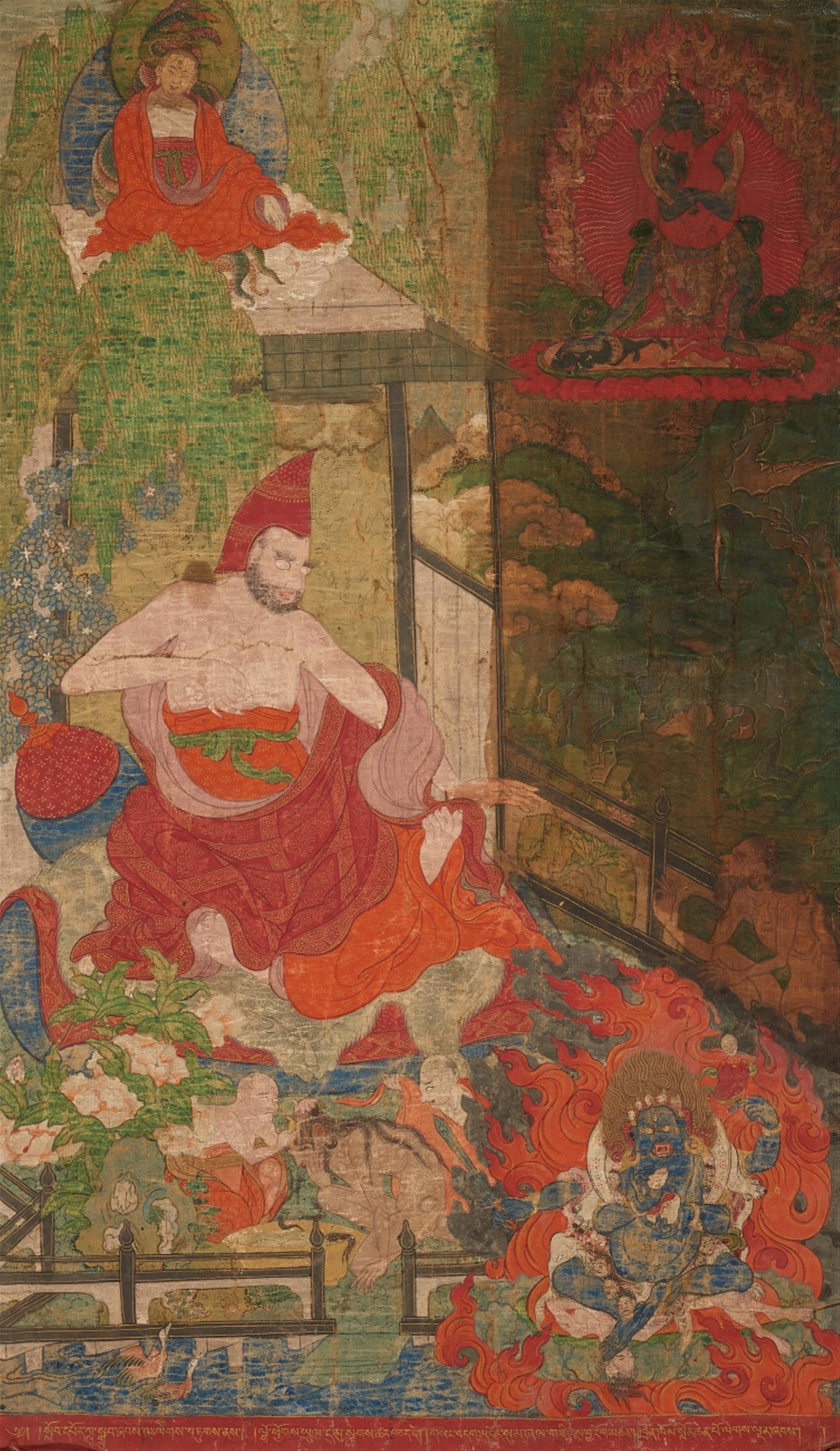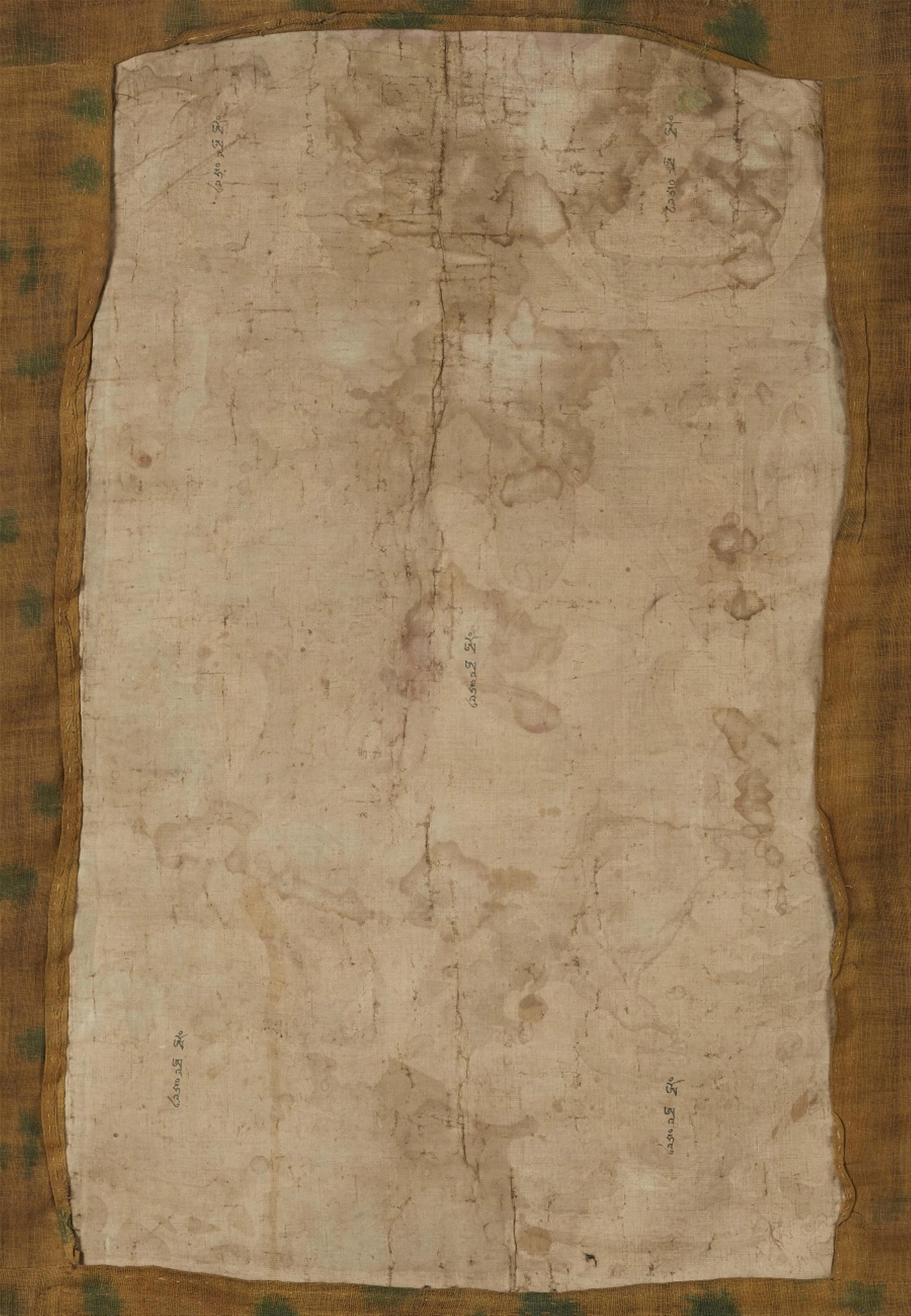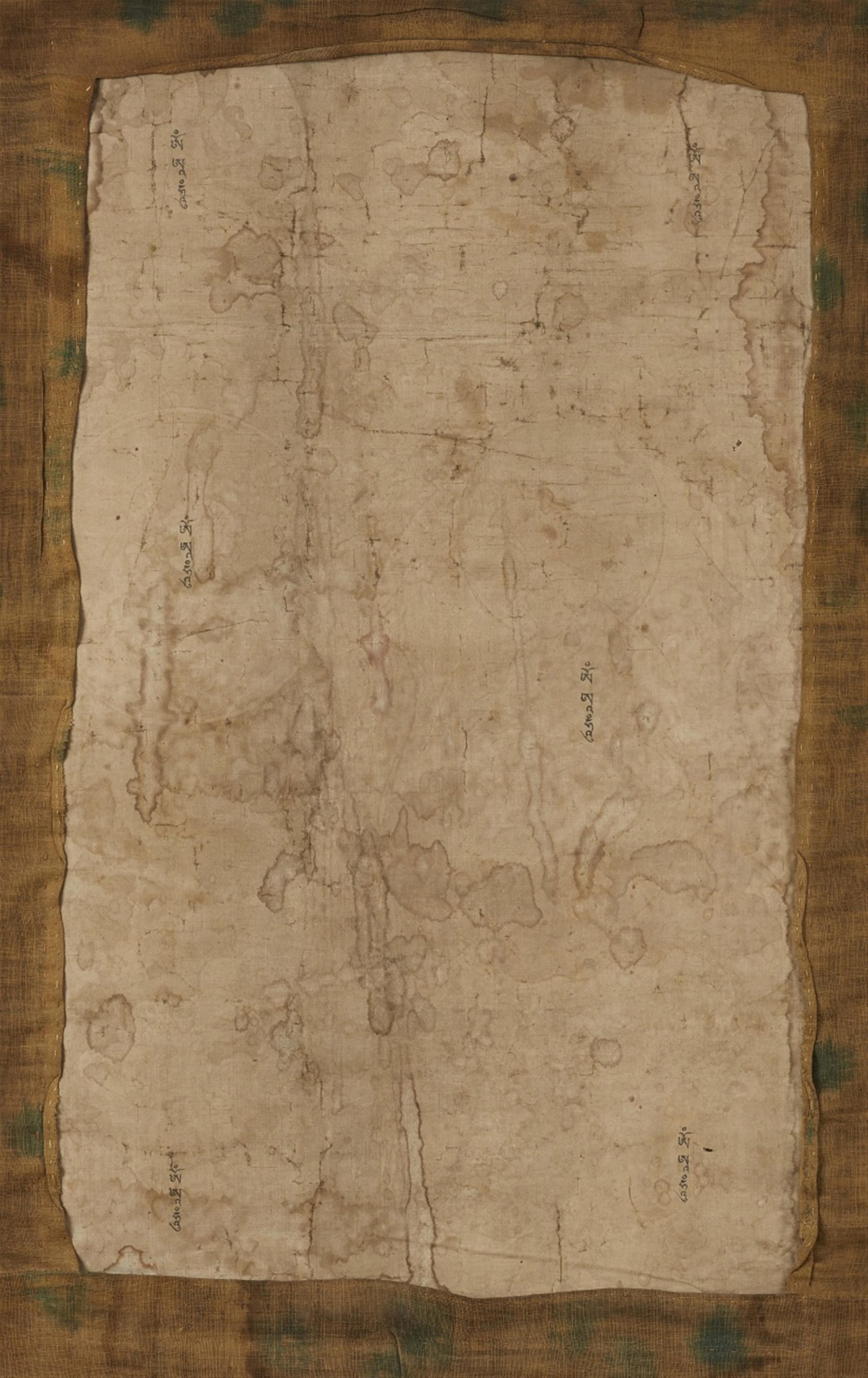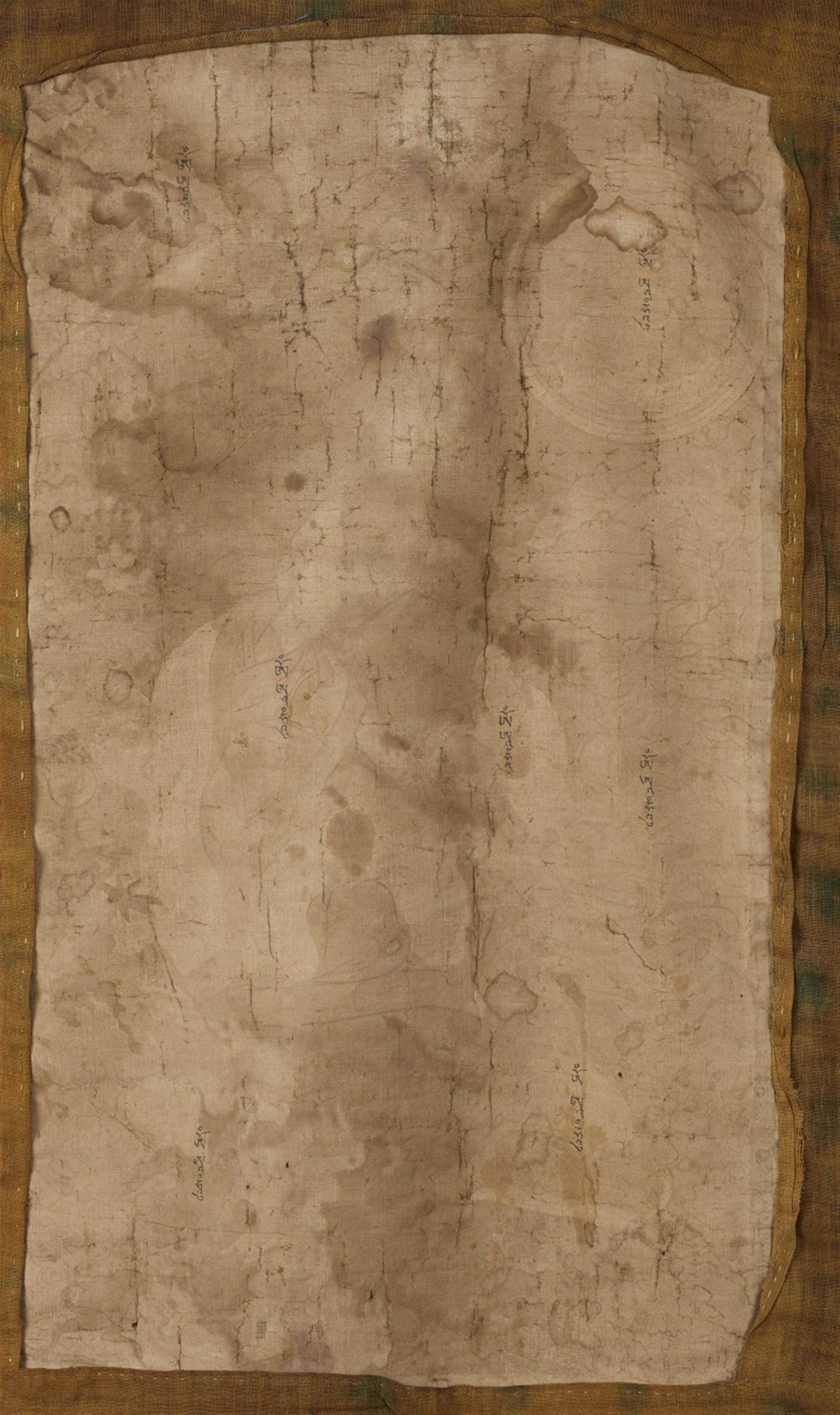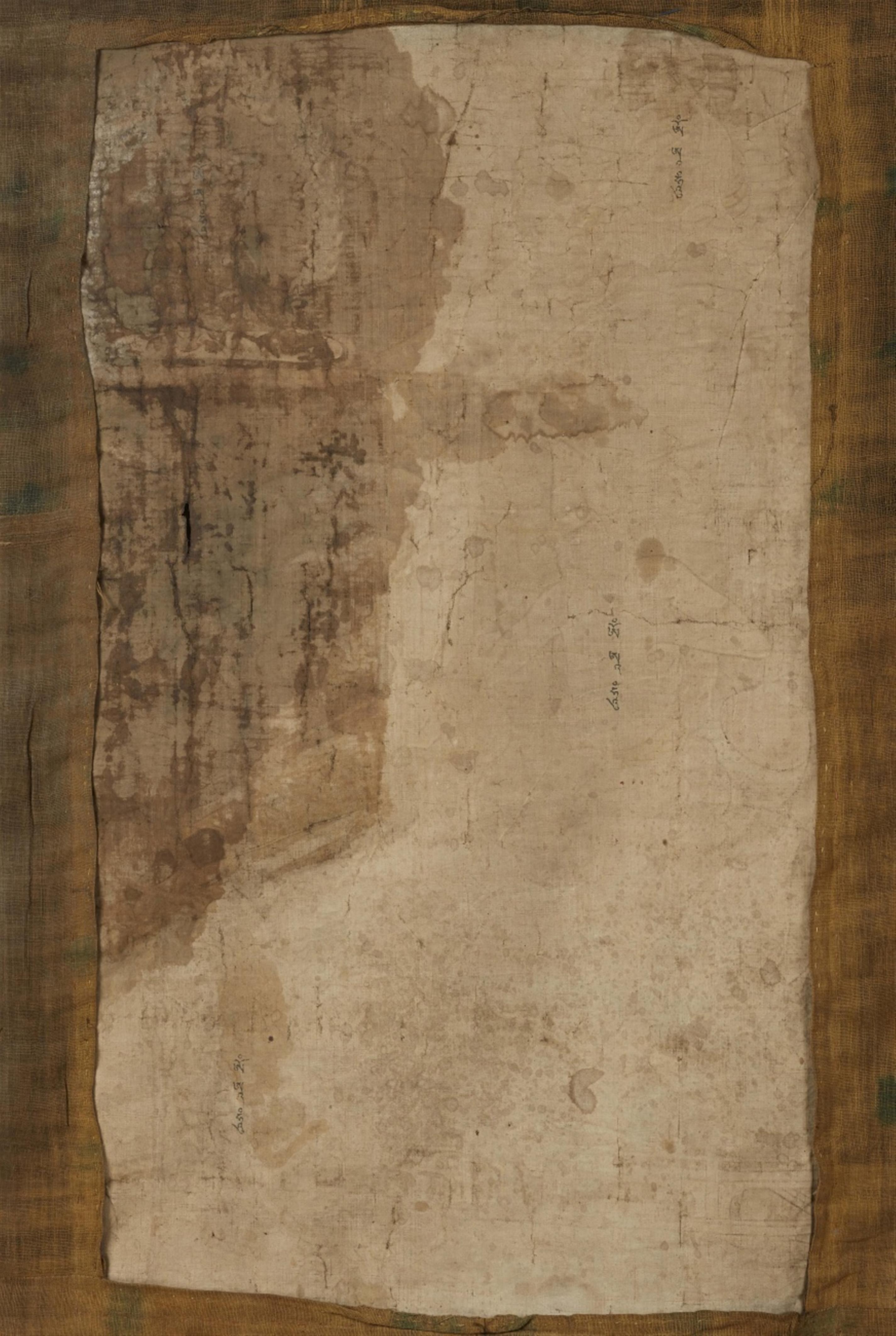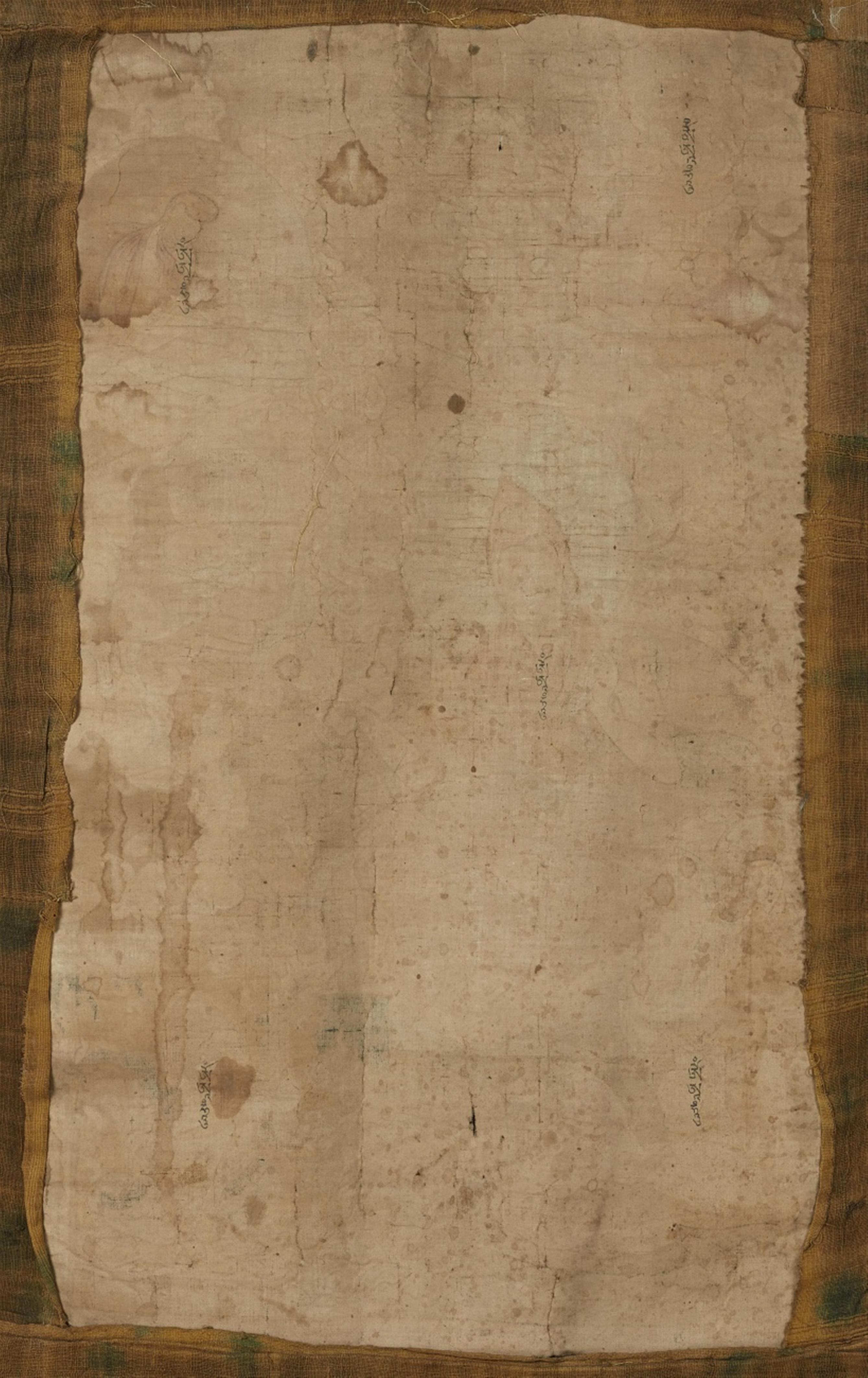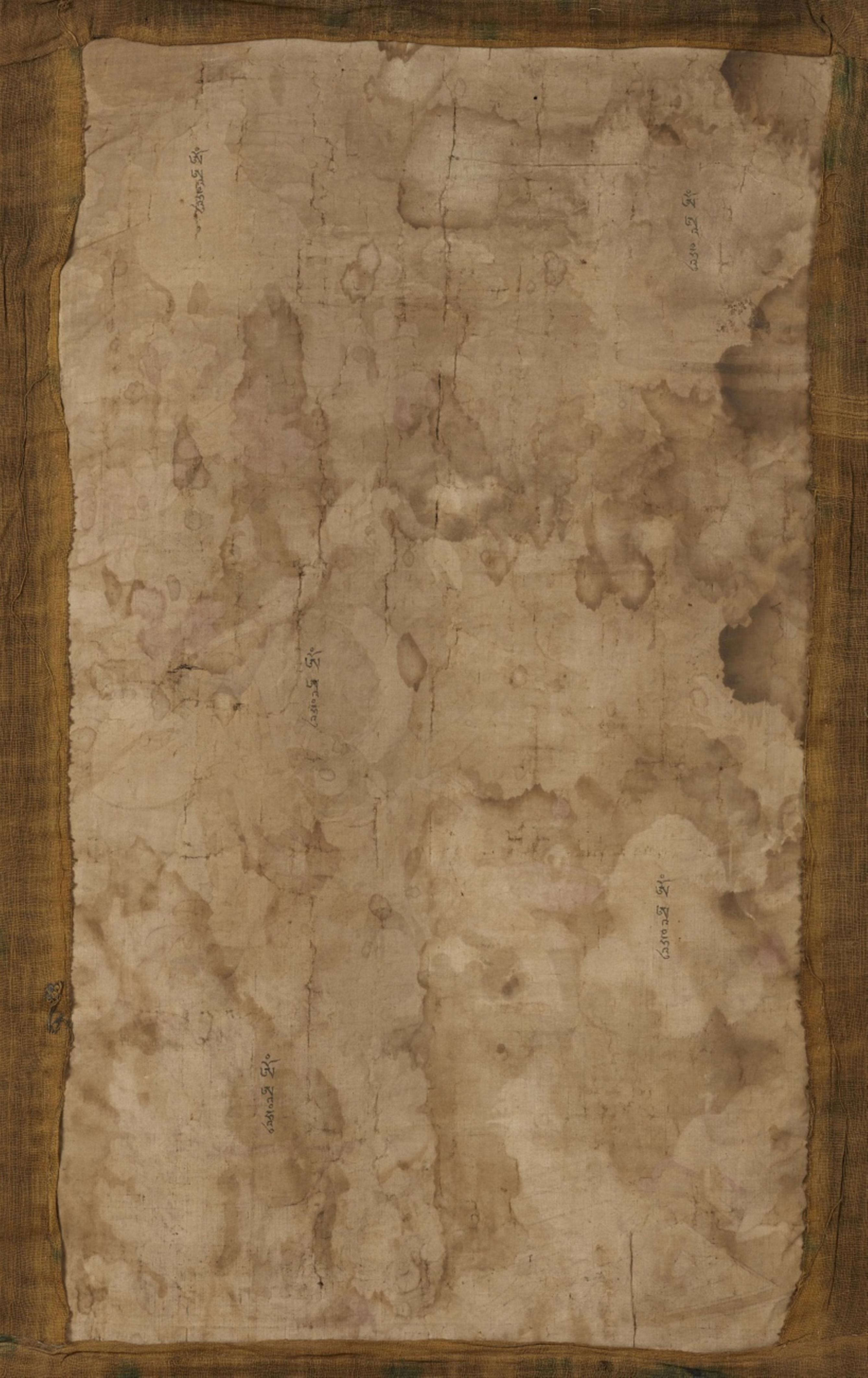An exceptionally rare set of six Tibetan thangkas celebrating the religious origin of the First Panchen Lama. 18th/19th century
Pigments and gold on cloth. Each thangka lined with a Tibetan inscription in gold at the lower border and set within a silk mount. (6)
Ca. 70 x 41 cm
The Panchen Lama lineage was established during the 17th century by the Fifth Dalai Lama, when he first bestowed the title of Panchen to his own teacher, Lobzang Chokyi Gyaltsen (1570-1662). The Panchen Lamas are seen as the second most important figure in the Gelugpa school of Tibetan Buddhism after the Dalai Lama. Thirteen eminent Tibetan and Indian scholars from earlier times are considered as the spiritual ancestors of the Panchen Lamas and are seen as their earlier incarnations.
All the compositions of the following paintings based on the famous set of wood block carvings and prints of the Narthang monastery, a set of likely thirteen portraits depicting the Panchen Lama lineage and their earlier incarnations. So this current set of six thangkas is supposely also a part of a larger set of likely thirteen paintings.
a) Lobzang Chokyi Gyaltsen
The First Panchen Lama holding a manuscript in his left hand, flanked by Maitreya in a rainbow circle, with Chakrasamvara in the upper left corner and Khedrup Sanggyue in the upper right, with Vaishravana on his snow lion at the lower left and the red Begtse to the lower right.
The First Panchen Lama, Lobzang Chokyi Gyaltsen (1570-1662), was the most important and most powerful Gelug teacher of his time, and he also was the tutor of the Fifth Dalai Lama (1617-1682).
69.5 x 40.6 cm
b) Ensapa Lobsang Dondrup
Seated on a noble red cushion, wearing precious monastic robes and a pandita hat, with his right hand pointing downwards to a follower and his left hand holding a string of prayer beads. The upper register with Chokyi Dorje in a rainbow circle to the left and Mahachakra Vajrapani to the right. Yama Dharmaraja is depicted in the lower right corner, all within a mountainous landscape.
Ensapa Lobsang Dondrup (1505-1566) was posthumously given the title of Panchen Lama around 1641, after his recognized reincarnation, Lobzang Chokyi (1570-1662) was nominated as Panchen Lama by the Fifth Dalai Lama.
c) Dorje Pal
Seated on a cushion atop a tiger skin, holding a kila in his right hand and extending a skull cup towards a wrathful deity with his left, dressed in voluminous robes and a pointed cap, with a seated lama holding a book at upper right, Rakta Yamari and Vajra Vetali standing on a buffalo at upper left, three monks seated at lower left, and Mahakala Gonpo Legpen at lower right, all within a mountainous landscape.
Yungdron Dorje Pal (1284-1365), principle disciple of the great Sakya master Buton Rinchen Drub, and according to Sakya tradition one of the previous incarnations of the Panchen Lamas.
70 x 40.7 cm
d) Sakya Pandita Kunga Gyaltsen
Seated in the centre on an elaborate dragon throne, debating with the naked Indian Shivaite ascetic Harinanda squating to the lower right, with Chaturmukha Mahakala to the left, with Maitreya as an ascetic standing in front of the Tushita palace to the upper left, and with Manjushri and Jetsun Dragpa Gyaltsen in clouds above, all within a mountainous landscape.
Sakya Pandita Kunga Gyaltsan (1182-1251) is perhaps the most important master of the Sakyapa school. Following a visit to China, he became viceroy of Tibet in 1249. According to Sakya tradition he is one of the previous incarnations of the Panchen Lamas.
70.5 x 42.5 cm
e) Abhayakaragupta
The scholar wearing red and gold brocade robes and a red Pandita usha with a snake wrapped around him, sitting on a cushion and receiving a kneeling worshipper, with Red Vajrayogini and Ratnasambhava at top and Panjara Mahakala at lower right.
Abhayakaragupta was an Indian Buddhist monk, scholar and tantric master. He was born in Eastern India, and is thought to have flourished in the late 11th/early 12th century, and died in 1125. According to Sakya tradition he is one of the previous incarnations of the Panchen Lamas.
70 x 41.5 cm
f) Bhavaviveka
Seated on a tiger skin over a magnificent red cushion, discussing with a Hindu from the Digambara school seated to his left, while two monks shave the head of an already converted Hindu, with the spiritual mentor Nagarjuna at upper left, Chakrasamvara at upper right and Mahakala at lower right.
Bhavaviveka was a famous Indian scholar who probably lived in the 6th century in Northern India, and is according to Sakya tradition one of the previous incarnations of the Panchen Lamas.
70 x 42 cm
西藏十八/十九世紀 罕見班禅喇嘛源流 - 一世班禅唐卡六尊唐卡
來源:德國北威州私人收藏
西藏十八/十九世纪
罕见班禅喇嘛源流 ——
一世班禅唐卡六尊唐卡
來源:德國北威州私人收藏
"班禅喇嘛”的称呼要追溯到17世纪五世达赖喇嘛之时。自此,历任班禅喇嘛都在日喀则的扎什伦布寺担任主持,并被认为是继达赖喇嘛后藏传佛教中最重要的宗教权威。
此处提供的6幅唐卡很可能来自一个由13幅唐卡组成的系列作品。
A)第四世班禅额尔德尼
第一世班禅喇嘛左手持一书卷,身旁伫着带彩虹背光的弥勒佛,左、右上方分别是胜乐金刚和格鲁·克珠·桑吉,下方的两位则是身骑雪狮的多闻天王和大红司命主。
第四世班禅额尔德尼(1570-1662)是其所处时代中最重要、最具影响力的格鲁派学者,此外,他也是第五世达赖喇嘛(1617-1682)的师父。
69.5 x 40.6 厘米
B)第三世班禅额尔德尼
他结跏趺坐于一个华丽枕头上,以右手指书,教导一名僧侣。
第三世班禅额尔德尼 (1505-1566) 是一位重要的藏族学者,于1641年左右被追封谥号班禅喇嘛。
69.5 x 41.6 厘米
C)运顿多吉白
这位喇嘛结跏趺坐于枕上的虎皮之上,右手持一把仪式短剑,左手将一个布满血的骷髅头递给一位可怕的神灵,在他的左上方,愄怖金刚与德金刚双身黑立于在水牛之上;画面的下半部分中,列于左侧的是若干僧侣及玛哈嘎拉·贡布·莱彭。
运顿多吉白(1284-1365)是杰出教师布敦仁钦珠最重要的学生,被认为是班禅喇嘛的前身之一。
70 x 40.7 厘米
D)萨迦·班智达
这位学者正在教导身前赤裸蹲坐的苦行僧哈里南达,身旁是四臂玛哈嘎拉,其上则是作为苦行僧立于兜率天前的弥勒佛,画面上方是文殊菩萨和扎巴坚赞。
萨迦·班智达(1182-1251)属于五位德高望重的大师之一,他们被认为是藏传佛教萨迦传统真正的奠基人。萨迦·班智达被认为是班禅喇嘛的前身之一。
70.5 x 42.5 厘米
E)无畏笈多大师
该学者身着缀以红、金色的锦缎长袍,头戴一顶红色班智达帽,一条蛇立于其右肩上,他坐于枕上,正在接见一个跪着的信徒。在图的上方,金刚亥母在左,宝生佛在右,右下角的金刚幕主玛哈嘎拉则站在火焰光环前。
无畏笈多大师生活在11/12世纪,是印度学者以及众多著作的作者。他被认为是班禅喇嘛的精神先驱之一,也是班禅喇嘛的前身。
70 x 41.5 厘米
F)清辩
这位学者坐于一个华丽的红枕之上,正与天衣派学校的印度教徒进行讨论,与此同时,两名僧侣则在为一名印度教徒剃发。在画面左上角可见龙树在左,胜乐金刚在右,面向其前方的火焰光环,右下角是玛哈嘎拉。
清辩是一位重要的印度学者,可能生活于6世纪的印度北部。他被认为是班禅喇嘛的前身之一。
70 x 42 厘米
Provenance
Private collection, North Rhine-Westphalia, Germany

